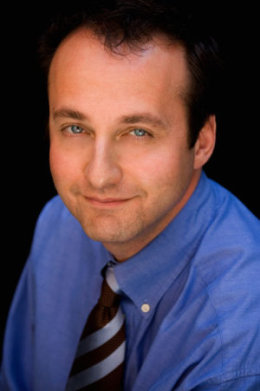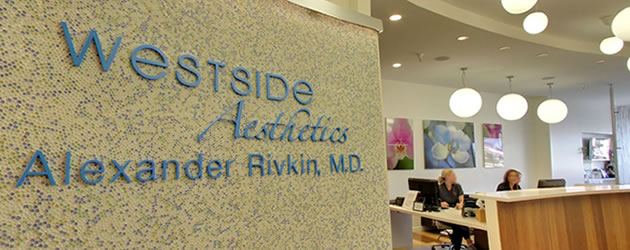Pioneer Of Non-Surgical Rhinoplasty, Dr. Alexander Rivkin In LA
Dr. Alexander Rivkin is an international authority on non-surgical cosmetic treatments who provides non-invasive and non-ablative treatments in Southern California.
 Name: Alexander Rivkin, MD
Name: Alexander Rivkin, MD
Clinic: Westside Aesthetics
Location: Los Angeles, CA
Website: Westside Aesthetics
That's Interesting: After several years of being an Allergan Clinical Educator, Dr. Rivkin was recently honored with Diamond level status: recognition that he is among the top 1% of Botox providers in the nation.
He is a prominent member of the national teaching faculties for Allergan, Contura, Johnson and Johnson, Medicis and Bioform. He is also a member of the physician advisory board for Contura and serves on the boards of a number of charities including the Lynne Cohen Foundation for Breast and Ovarian Cancer Research.
I first met Dr. Rivkin somewhere around 2002 when I was attending a "medical spa conference" and Westside Aesthetics was on the tour. At the time, Westside Aesthetics was located above a salon but now Westside Medical Spa is tucked away on Gayley Avenue near UCLA.
Dr. Rivkin is renowned for non-surgical alternatives to commonly performed cosmetic procedures. He was the first physician in the country to offer the Non-Surgical Nose Job, his signature method for non-invasive correction of cosmetic nasal irregularities.

How is Westside Aesthetics organized as a medical spa?
My clinic is 100% non surgical aesthetic procedures, with the exception of Botox for TMJ, migraines and hyperhidrosis. I have 3 injection rooms, 3 nursing rooms and one esthetician room. There are usually 2 doctors working (myself and my associate) the injection rooms and one or two nurses doing laser and injection procedures in their rooms. I have an office manager and three front desk staff on at a given time, along with an assistant for me. My patient population is varied, but a lot find us through the internet, where most of my marketing efforts have been concentrated. As a result, my patients are mostly on the younger side.
We're in Brentwood – an area of West Los Angeles.
You've received a lot of attention as one of the first docs who started using Botox and fillers in a much more comprehensive way. Can you tell us a little bit about how you started your cosmetic practice and decided to focus on injectables?
I started practice just as the first non collagen injectable fillers were being FDA approved. Botox was still a relatively new phenomenon and it felt like a new specialty was being born. It was exciting because we were developing new techniques that had never been tried before with materials that had never been used in aesthetic medicine.
I wanted to concentrate on non-surgical cosmetic procedures. I felt there was so much that was possible without doing surgery, and I could be creative in this field and “make up stuff.” I really couldn’t be creative in a more traditional practice. I have focused my efforts on new ways of accomplishing things that my patients want without having to put them through the ordeal of surgery.
I started out by using the things that were available. It’s exciting now because there are new injectibles and new lasers that are coming out. I believe that this is the future. So it’s very interesting to be on that wave and utilize these new things that are coming out. The start of my whole thinking was with the nose. I came up with a procedure that can straighten the nose without surgery. Afterwards, I’ve been listening to my patients and trying to go with some of the problems they would ask me about.
At one point a patient walked in and she was tense. She wore the tension around her jaw. And I was looking at her and noticed her jaw was square. I had read where these doctors in Asia had been injecting botox into the muscles of the jaws for girls who wanted to soften their jaw line cosmetically–just to look different. So I asked her if she had had a square jaw for a while, and she said ever since she had been grinding her teeth, her jaw had become more muscular and square. All night and during the day she would grind her teeth. Her dentist had given her devices to wear at night. But she would literally spit them out unconsciously in her sleep, or grind them up and spit out the pieces. This isn’t the first time I had heard of this. These people literally grind their teeth every night, working out these muscles, which eventually become huge and rock hard. So I thought to myself, “it’s only a muscle.” So I started putting botox into it. There were a bunch of little ones. She returned to me and reported that she stopped grinding. She looked more calm and felt more calm. ”This is the best thing since sliced bread.” So I wrote to the company, and I said, “I am sure that this is something that had been tried.” And they confirmed it. It had occurred to other people as well, but it made sense.
You start grinding and your muscles just get stronger and stronger with each grinding episode. After a certain point, there’s nothing you can do to stop it because your muscles get too strong, and you’re doing it completely unconsciously. The more you do it, your teeth get worn down, but then when you’re aware of it, it makes the grinder more tense that they cannot stop grinding their teeth. But once you put the botox in, the muscle has the strength to chew and function properly, but it doesn’t have the strength to grind. Then it just stops.
You are a surgeon... Nonsurgical?
The freedom to be creative is really important to me. You can’t do that in surgery. You have to do the procedure the way it is. You can’t make things up. A lot of people are getting needless surgery. I am the kind of surgeon that would counsel people away from surgery, and into non-invasive techniques. But I knew that being a part-time surgeon is no good. You have to stay on top of your game and do it all the time. I decided to go with what my heart was really into, which is this kind of stuff. I felt like this is where the future of aesthetic medicine is going to be.
Surgically, to extend your chin, you have to get an operation. There is an incision underneath. You open up the skin, you slide in the implant, you close up the skin. You’re limited in terms of what the implant looks like. Surgically, there’s a limitation in terms of what the shape of the chin is going to look like. You’re limited by the implant that you have, and you’re also limited when you do it, because you can’t adjust on the fly. You have to surmise, “O. K., we will use implant #2.” Once it’s open, you can’t see aesthetically what it’s going to look like. You just have to hope for the best. I do injections. I take a filler substance called Radiesse(TM). It lasts for about a year and a half. I put it in the deeper layers of the skin—that’s where it belongs. When you put it in, you can mold it like clay. The substance is calcium based. It’s kind of like a lattice, or a scaffolding, where the body’s cells grow into it and it becomes like the skin. It’s soft, and you can’t tell the difference. When it first goes in, you can move it around, mold it. I look at the person in the chair and I can tell which direction I want to go—square it off, make it delicate, pointy, out, down, etc. You can make it be more appropriate to the individual who’s in front of you. Therefore, you can make it more precise, and fine tune it.
Together with your staff, how do you ensure patient satisfaction? How do you manage and compensate your staff?
An aesthetic clinic has to have nice, warm and friendly staff at the front desk. Patients have to feel like they are walking into a service establishment, not a doctor’s office. Staff also must be very knowledgeable about all procedures and products. Staff also must look the part – well put together and attractive (but I will never sacrifice brains for beauty). My office manager handles hiring and firing with me. I pay staff a commission that varies with their role. This has been effective as incentive to know all of the procedures inside and out.
You're all about nonsurgical. What IPL or laser technologies are you using?
I use the Lumenis IPL, Fraxel, Thermage, Lumenis Active Fx, Candela V beam, Alma Soprano and Velashape devices. I purchase new devices when I feel there is a need and a sufficient interest from patients to warrant the price. I am very skeptical of new devices and will never be a first adopter. I dismiss all claims and always demand to try the device out on my patients. If I see good results, I will then go ahead.
About: Dr. Alexander Rivkin is a cosmetic surgeon and an Assistant Clinical Instructor in the Department of Medicine, Division of Dermatology at the UCLA, David Geffen School of Medicine. His practice, Westside Aesthetics, is focused on developing and perfecting non-invasive, non-ablative cosmetic treatments. He is best known for developing and popularizing the Non Surgical Rhinoplasty procedure. He received his MD from Yale and his residency was in Otolaryngology/Head and Neck Surgery at the University of California, San Diego. He is a member of the National Education Faculty for all of the major cosmetic injectables’ manufacturers and trains physicians on noninvasive aesthetic techniques.
This interview is part of a series of interviews of physicians running medical spas, laser clinics and cosmetic surgery centers. If you'd like to be interviewed, just contact us.